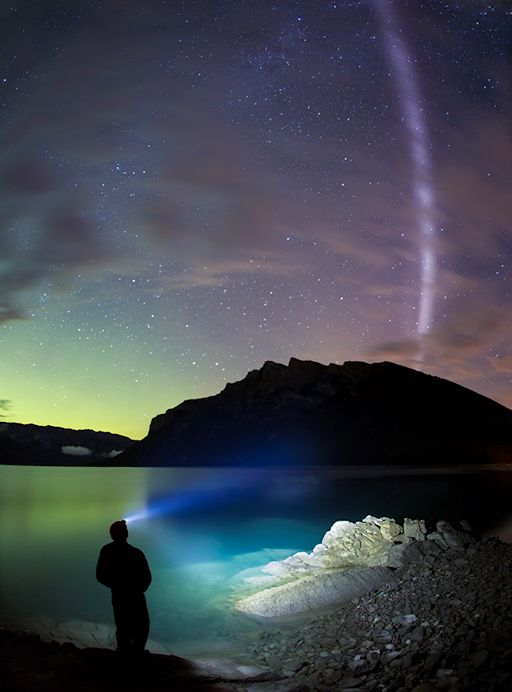 at www.spaceweather.com (August 19th 2015) a rare form of aurora emanating from a class G3 geomagnetic storm erupted on Augsut 15th when a CME hit Earth's magnetic field. Two nights later, on the 17th, just as the storm was subsiding, skywatchers in N America witnessed a 'proton arc' (the image above was photographed at Banff, and you might recognise the lake in the forefront, by one Paul Zikla). It did not just occur in Alberta but was photographed in Washington State as well – during one of those camping or trailer shindigs where everybody sits around the campfire long into the night. The pillar or arc, remained stationary for 30 minutes.
at www.spaceweather.com (August 19th 2015) a rare form of aurora emanating from a class G3 geomagnetic storm erupted on Augsut 15th when a CME hit Earth's magnetic field. Two nights later, on the 17th, just as the storm was subsiding, skywatchers in N America witnessed a 'proton arc' (the image above was photographed at Banff, and you might recognise the lake in the forefront, by one Paul Zikla). It did not just occur in Alberta but was photographed in Washington State as well – during one of those camping or trailer shindigs where everybody sits around the campfire long into the night. The pillar or arc, remained stationary for 30 minutes.
Ordinary aurora are caused by electrons raining down on Earth's atmosphere from above. Atoms of oxygen and nitrogen, excited by the electrons, form dynamic curtains of light. Protons have a different effect. For reasons not understood protons trapped in Earth's 'ring current' sometimes rain down towards the surface during geomagnetic storms and they seem to excite a plasma wave – which produces the arc of light. In other words, you are looking at a plasma wave.
![]() Astronauts onboard the Space Station witnessed red sprites sprouting from the tops of a cluster of storms over Mexico – and photographed them (above). This shows just how high sprites (lightning) can reach – from thunderstorms to a region of green airglow (see above), some 100km above the surface of the Earth. Sprites therefore touch the edge of space – and connect with space. A few minutes after this (see small picture in corner) the astronauts spotted a related feature – trolls. These are secondary transient luminous events, occasionally observed alongside clusters of sprites. It seems the sprites (or upward rising lightning discharges) can actually bring down Earth's ionosphere (or the solar wind may play a role). When the gap shrinks the local electric field intensifies – and trolls appear. It seems they don't all hide under bridges.
Astronauts onboard the Space Station witnessed red sprites sprouting from the tops of a cluster of storms over Mexico – and photographed them (above). This shows just how high sprites (lightning) can reach – from thunderstorms to a region of green airglow (see above), some 100km above the surface of the Earth. Sprites therefore touch the edge of space – and connect with space. A few minutes after this (see small picture in corner) the astronauts spotted a related feature – trolls. These are secondary transient luminous events, occasionally observed alongside clusters of sprites. It seems the sprites (or upward rising lightning discharges) can actually bring down Earth's ionosphere (or the solar wind may play a role). When the gap shrinks the local electric field intensifies – and trolls appear. It seems they don't all hide under bridges.
